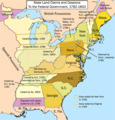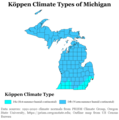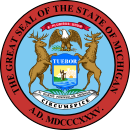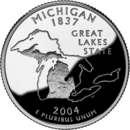Portal:Michigan
The Michigan Portal  Michigan (/ˈmɪʃɪɡən/ MISH-ig-ən) is a state in the Great Lakes region of the Upper Midwest region of the United States. It borders Wisconsin to the northwest in the Upper Peninsula, and Indiana and Ohio to the south in the Lower Peninsula; it is also connected by Lakes Superior, Michigan, Huron, and Erie to Minnesota and Illinois, and the Canadian province of Ontario. With a population of nearly 10.12 million and an area of 96,716 sq mi (250,490 km2), Michigan is the 10th-largest state by population, the 11th-largest by area, and the largest by area east of the Mississippi River. Its capital is Lansing, and its largest city is Detroit. Metro Detroit is among the nation's most populous and largest metropolitan economies. The name derives from a gallicized variant of the original Ojibwe word ᒥᓯᑲᒥ (mishigami), meaning "large water" or "large lake". Michigan consists of two peninsulas. The Lower Peninsula resembles the shape of a mitten, and comprises a majority of the state's land area. The Upper Peninsula (often called "the U.P.") is separated from the Lower Peninsula by the Straits of Mackinac, a five-mile (8 km) channel that joins Lake Huron to Lake Michigan. The Mackinac Bridge connects the peninsulas. Michigan has the longest freshwater coastline of any political subdivision in the United States, being bordered by four of the five Great Lakes and Lake St. Clair. It also has 64,980 inland lakes and ponds. Michigan has the second-most water area of any state, behind only Alaska. The area was first occupied by a succession of Native American tribes over thousands of years. In the 17th century, French explorers claimed it as part of the New France colony, when it was largely inhabited by Indigenous peoples. French and Canadian traders and settlers, Métis, and others migrated to the area, settling largely along the waterways. After France's defeat in the French and Indian War in 1762, the region came under British rule. Britain ceded the territory to the newly independent United States after its defeat in the American Revolutionary War. The area was part of the larger Northwest Territory until 1800, when western Michigan became part of the Indiana Territory. Michigan Territory was formed in 1805, but some of the northern border with Canada was not agreed upon until after the War of 1812. Michigan was admitted into the Union in 1837 as the 26th state, a free one. It soon became an important center of industry and trade in the Great Lakes region, attracting immigrants in the late 19th and early 20th centuries from many European countries. Immigrants from Finland, Macedonia, and the Netherlands were especially numerous. Migration from Appalachia and of Black Southerners as part of the Great Migration increased in the 1930s, with many settling in Metro Detroit. Although Michigan has developed a diverse economy, in the early 20th century it became widely known as the center of the U.S. automotive industry, which developed as a major national economic force. It is home to the country's three major automobile companies (whose headquarters are all in Metro Detroit). Once exploited for logging and mining, today the sparsely populated Upper Peninsula is important for tourism because of its abundance of natural resources. The Lower Peninsula is a center of manufacturing, forestry, agriculture, services, and high-tech industry. (Full article...) Entries here consist of Good and Featured articles, which meet a core set of high editorial standards.
SS Edmund Fitzgerald was an American Great Lakes freighter that sank in Lake Superior during a storm on November 10, 1975, with the loss of the entire crew of 29 men. When launched on June 7, 1958, she was the largest ship on North America's Great Lakes and remains the largest to have sunk there. She was located in deep water on November 14, 1975, by a U.S. Navy aircraft detecting magnetic anomalies, and found soon afterwards to be in two large pieces. For 17 years, Edmund Fitzgerald carried taconite (a variety of iron ore) from mines near Duluth, Minnesota, to iron works in Detroit, Michigan; Toledo, Ohio; and other Great Lakes ports. As a workhorse, she set seasonal haul records six times, often breaking her own record. Captain Peter Pulcer was known for piping music day or night over the ship's intercom while passing through the St. Clair and Detroit rivers (between Lake Huron and Lake Erie), and entertaining spectators at the Soo Locks (between Lakes Superior and Huron) with a running commentary about the ship. Her size, record-breaking performance, and "DJ captain" endeared Edmund Fitzgerald to boat watchers. (Full article...)Selected picture - Sylvania Wilderness is an 18,327-acre (74 km2) area of land located a few miles west of Watersmeet, Michigan. The area is located entirely within the bounds of the Ottawa National Forest, and is currently being managed as a wilderness area as part of the National Wilderness Preservation System by the U.S. Forest Service. Did you know -
Related portalsSelected article -James Riddle Hoffa (born February 14, 1913 – disappeared July 30, 1975, declared dead July 30, 1982) was an American labor union leader who served as the president of the International Brotherhood of Teamsters (IBT) from 1957 until 1971. From an early age, Hoffa was a union activist, and he became an important regional figure with the IBT by his mid-20s. By 1952, he was the national vice-president of the IBT and between 1957 and 1971 he was its general president. He secured the first national agreement for teamsters' rates in 1964 with the National Master Freight Agreement. He played a major role in the growth and the development of the union, which eventually became the largest by membership in the United States, with over 2.3 million members at its peak, during his terms as its leader. (Full article...)Selected biography -Daniel Leonard Dworsky (October 4, 1927 – January 19, 2022) was an American architect who was a longstanding member of the American Institute of Architects College of Fellows. Among other works, Dworsky designed Crisler Arena, the basketball arena at the University of Michigan named for Dworsky's former football coach, Fritz Crisler. Other professional highlights include designing Drake Stadium at UCLA, the Federal Reserve Bank in Los Angeles and the Block M seating arrangement at Michigan Stadium. He is also known for a controversy with Frank Gehry over the Walt Disney Concert Hall. Previously, Dworsky was an American football linebacker, fullback and center who played professional football for the Los Angeles Dons of the All-America Football Conference (AAFC) in 1949, and college football for the Michigan Wolverines from 1945 to 1948. He was an All-American on Michigan's undefeated national championship teams in 1947 and 1948. (Full article...)General imagesThe following are images from various Michigan-related articles on Wikipedia.
TopicsCategoriesSymbols
Lists
Related pagesWikimediaThe following Wikimedia Foundation sister projects provide more on this subject:
Things you can doDiscover Wikipedia using portals | ||||||||||||||||||||||||||||||||||||











































































